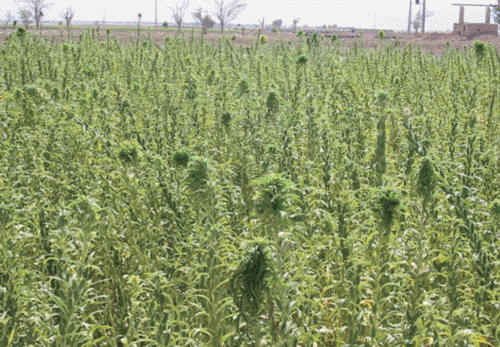The first report of transmission of a phytoplasma associated with sesame phyllody by Orosius albicinctus in Iran
S. A. Esmailzadeh-Hosseini A D , A. Mirzaie B , A. Jafari-Nodooshan A and H. Rahimian CA Yazd Agricultural and Natural Resources Research Center, Plant Pests and Diseases Research Department, Yazd, Iran.
B Agricultural Biotechnology Research Institute of Iran, Karaj, Iran.
C Plant Protection Department, Mazandaran University, Sari, Iran.
D Corresponding author. Email: saesmailzadeh@yahoo.com
Australasian Plant Disease Notes 2(1) 33-34 https://doi.org/10.1071/DN07016
Submitted: 31 January 2006 Accepted: 12 March 2007 Published: 3 April 2007
Abstract
During 2003–05, a survey for phytoplasmas was carried out in sesame fields in Yazd province (Iran). The leafhopper Orosius albicinctus was collected and found to contain a phytoplasma. Transmission tests were performed under greenhouse conditions. The indicator plants were alfalfa, rapeseed, garden beet, sesame, radish, periwinkle and garden cress. A nested polymerase chain reaction using phytoplasma universal primers was used to detect phytoplasmas in indicator plants and leafhoppers. Amplification of a phytoplasma-characteristic 1.2-kb 16 S rDNA fragment confirmed that sesame, garden cress and garden beet plants were infected by the phytoplasma. On the basis of RFLP analysis of the amplified DNA fragments using five endonucleases, the detected phytoplasma belonged to the 16SrII group (peanut witches’ broom phytoplasma). This is the first report of transmission of a phytoplasma associated with sesame phyllody by O. albicinctus in Iran.
Phyllody is one of the most important diseases of sesame (Sesamum indicum) in Iran. The disease incidence varies in different regions of the country. The leafhopper Neoaliturus haematoceps transmits the phytoplasma associated with sesame phyllody in Fars province (Salehi and Izadpanah 1991). The major disease symptoms are virescence, phyllody, yellowing, flower sterility and stem proliferation (Fig. 1). During 2003–05, up to 70% of the plants affected with phyllody were observed in sesame growing regions in Yazd province. The leafhopper Orosius albicinctus was collected from these sesame fields. They were found to contain a phytoplasma using polymerase chain reaction (PCR) with the universal primer pair R16F2n/R16R2.

|
To demonstrate that O. albicinctus is able to transmit the phytoplasma, transmission tests were conducted in greenhouse conditions. For phytoplasma transmission, infected plants with disease symptoms were collected and transferred to the greenhouse. Leafhoppers, which were collected by net-sweeping from sesame fields, fed periodically on healthy plants for 20 days. This was done five times. Colonies were checked and vectors with negative reaction in PCRs using universal primers were used for transmission tests. Leafhoppers were given a 30-day acquisition access period on infected plants, and then transferred to indicator plants at the third leaf stage using five leafhoppers per plant. The indicator plants used in this research were alfalfa (Medicago sativa cv. Yazdi), rapeseed (Brassica napus), garden beet (Beta vulgaris sub. sp. esculenta), sesame (Sesamum indicum), radish (Raphanus sativus.), periwinkle (Catharantus roseus) and garden cress (Lepidium sativum). After a 21-day inoculation access period under greenhouse conditions, leafhoppers were preserved at –20°C for DNA extractions. Test plants were observed for symptom development for at least two months after inoculation. Control seedlings were infested with leafhoppers from healthy plants. A nested PCR using the phytoplasma universal primer pair R16mF2/R16mR1 in the first amplification followed by R16F2n/R16R2 in the second amplification was used to detect phytoplasmas in the indicator plants and leafhoppers. A sample of lime (Citrus aurantifolia) infected with Iranian lime witches’ broom phytoplasma (Bove et al. 2000) collected from Hormozgan, southern Iran, served as a reference in the molecular characterisation tests of phytoplasmas in indicator plants.
Amplification of a phytoplasma-characteristic 1.2-kb 16 S rDNA fragment in the nested reactions primed by R16F2n/R16R2 confirmed that sesame, garden cress and garden beet plants were infected by a phytoplasma. Sesame showed little leaf, leaf yellowing and phyllody. Garden cress showed leaf abnormality and flower sterility. Garden beet became dwarfed and no flowers were produced. Phytoplasma DNA was not amplified from the symptomless indicator plants or in healthy plants. The phytoplasma was identified according to the system of Lee et al. (1998) using restriction digests of the R16F2n/R16R2 PCR products with the endonucleases TaqI, RsaI, HaeIII, Sau3AI and Tru9I. Similar restriction fragment length polymorphism (RFLP) profiles were produced for all sesame samples. RFLP patterns of 16 S rDNA suggested that sesame phyllody phytoplasma in Yazd belonged to the 16SrII group (peanut witches’ broom phytoplasma). Sequencing of the amplified products and phylogenetic analysis of 16 S rDNA from indicator plants has not yet been done. This is the first report of transmission of a phytoplasma associated with sesame phyllody by O. albicinctus in Iran.
Lee IM,
Gundersen DE,
Davis RE, Bartoszyk IM
(1998) Revised classification scheme of phytoplasmas based on RFLP analyses of 16S rRNA and ribosomal protein gene sequences. International Journal of Systematic Bacteriology 48, 1153–1169.



